The Atomic Human and Africa’s Digital Future
Abstract
The Atomic Human is suggests that humans are defined by their limitations and how we overcome them. Ovecoming hese limitations builds on our cultures and communities. Modern institutions are adapted to European models of community interaction that when imposed on the African context doesn’t allow the strengths and aspirations of local people to emerge. The new wave of AI offers an opportunity for people to build institutions that respect their own cultural contexts and align with the aspirations of people from across the countries, cities, towns and villages of the African continent.
Henry Ford’s Faster Horse


Figure: A 1925 Ford Model T built at Henry Ford’s Highland Park Plant in Dearborn, Michigan. This example now resides in Australia, owned by the founder of FordModelT.net. From https://commons.wikimedia.org/wiki/File:1925_Ford_Model_T_touring.jpg
It’s said that Henry Ford’s customers wanted a “a faster horse”. If Henry Ford was selling us artificial intelligence today, what would the customer call for, “a smarter human”? That’s certainly the picture of machine intelligence we find in science fiction narratives, but the reality of what we’ve developed is much more mundane.
Car engines produce prodigious power from petrol. Machine intelligences deliver decisions derived from data. In both cases the scale of consumption enables a speed of operation that is far beyond the capabilities of their natural counterparts. Unfettered energy consumption has consequences in the form of climate change. Does unbridled data consumption also have consequences for us?
If we devolve decision making to machines, we depend on those machines to accommodate our needs. If we don’t understand how those machines operate, we lose control over our destiny. Our mistake has been to see machine intelligence as a reflection of our intelligence. We cannot understand the smarter human without understanding the human. To understand the machine, we need to better understand ourselves.
Artificial General Vehicle


Figure: The notion of artificial general intelligence is as absurd as the notion of an artificial general vehicle - no single vehicle is optimal for every journey. (Illustration by Dan Andrews inspired by a conversation about “The Atomic Human” Lawrence (2024))
This illustration was created by Dan Andrews inspired by a conversation about “The Atomic Human” book. The drawing emerged from discussions with Dan about the flawed concept of artificial general intelligence and how it parallels the absurd idea of a single vehicle optimal for all journeys. The vehicle itself is inspired by shared memories of Professor Pat Pending in Hanna Barbera’s Wacky Races.
I often turn up to talks with my Brompton bicycle. Embarrassingly I even took it to Google which is only a 30 second walk from King’s Cross station. That made me realise it’s become a sort of security blanket. I like having it because it’s such a flexible means of transport.
But is the Brompton an “artificial general vehicle”? A vehicle that can do everything? Unfortunately not, for example it’s not very good for flying to the USA. There is no artificial general vehicle that is optimal for every journey. Similarly there is no such thing as artificial general intelligence. The idea is artificial general nonsense.
That doesn’t mean there aren’t different principles to intelligence we can look at. Just like vehicles have principles that apply to them. When designing vehicles we need to think about air resistance, friction, power. We have developed solutions such as wheels, different types of engines and wings that are deployed across different vehicles to achieve different results.
Intelligence is similar. The notion of artificial general intelligence is fundamentally eugenic. It builds on Spearman’s term “general intelligence” which is part of a body of literature that was looking to assess intelligence in the way we assess height. The objective then being to breed greater intelligences (Lyons, 2022).
The Atomic Human

Figure: The Atomic Eye, by slicing away aspects of the human that we used to believe to be unique to us, but are now the preserve of the machine, we learn something about what it means to be human.
The development of what some are calling intelligence in machines, raises questions around what machine intelligence means for our intelligence. The idea of the atomic human is derived from Democritus’s atomism.
In the fifth century bce the Greek philosopher Democritus posed a question about our physical universe. He imagined cutting physical matter into pieces in a repeated process: cutting a piece, then taking one of the cut pieces and cutting it again so that each time it becomes smaller and smaller. Democritus believed this process had to stop somewhere, that we would be left with an indivisible piece. The Greek word for indivisible is atom, and so this theory was called atomism.
The Atomic Human considers the same question, but in a different domain, asking: As the machine slices away portions of human capabilities, are we left with a kernel of humanity, an indivisible piece that can no longer be divided into parts? Or does the human disappear altogether? If we are left with something, then that uncuttable piece, a form of atomic human, would tell us something about our human spirit.
See Lawrence (2024) atomic human, the p. 13.
Embodiment Factors
| bits/min | billions | 2,000 |
|
billion calculations/s |
~100 | a billion |
| embodiment | 20 minutes | 5 billion years |

Figure: Embodiment factors are the ratio between our ability to compute and our ability to communicate. Relative to the machine we are also locked in. In the table we represent embodiment as the length of time it would take to communicate one second’s worth of computation. For computers it is a matter of minutes, but for a human, it is a matter of thousands of millions of years. See also “Living Together: Mind and Machine Intelligence” Lawrence (2017)
There is a fundamental limit placed on our intelligence based on our ability to communicate. Claude Shannon founded the field of information theory. The clever part of this theory is it allows us to separate our measurement of information from what the information pertains to.1
Shannon measured information in bits. One bit of information is the amount of information I pass to you when I give you the result of a coin toss. Shannon was also interested in the amount of information in the English language. He estimated that on average a word in the English language contains 12 bits of information.
Given typical speaking rates, that gives us an estimate of our ability to communicate of around 100 bits per second (Reed and Durlach, 1998). Computers on the other hand can communicate much more rapidly. Current wired network speeds are around a billion bits per second, ten million times faster.
When it comes to compute though, our best estimates indicate our computers are slower. A typical modern computer can process make around 100 billion floating-point operations per second, each floating-point operation involves a 64 bit number. So the computer is processing around 6,400 billion bits per second.
It’s difficult to get similar estimates for humans, but by some estimates the amount of compute we would require to simulate a human brain is equivalent to that in the UK’s fastest computer (Ananthanarayanan et al., 2009), the MET office machine in Exeter, which in 2018 ranked as the 11th fastest computer in the world. That machine simulates the world’s weather each morning, and then simulates the world’s climate in the afternoon. It is a 16-petaflop machine, processing around 1,000 trillion bits per second.
See Lawrence (2024) embodiment factor p. 13, 29, 35, 79, 87, 105, 197, 216-217, 249, 269, 353, 369.
Bandwidth Constrained Conversations

Figure: Conversation relies on internal models of other individuals.

Figure: Misunderstanding of context and who we are talking to leads to arguments.
Embodiment factors imply that, in our communication between humans, what is not said is, perhaps, more important than what is said. To communicate with each other we need to have a model of who each of us are.
To aid this, in society, we are required to perform roles. Whether as a parent, a teacher, an employee or a boss. Each of these roles requires that we conform to certain standards of behaviour to facilitate communication between ourselves.
Control of self is vitally important to these communications.
The high availability of data available to humans undermines human-to-human communication channels by providing new routes to undermining our control of self.
The consequences between this mismatch of power and delivery are to be seen all around us. Because, just as driving an F1 car with bicycle wheels would be a fine art, so is the process of communication between humans.
If I have a thought and I wish to communicate it, I first need to have a model of what you think. I should think before I speak. When I speak, you may react. You have a model of who I am and what I was trying to say, and why I chose to say what I said. Now we begin this dance, where we are each trying to better understand each other and what we are saying. When it works, it is beautiful, but when mis-deployed, just like a badly driven F1 car, there is a horrible crash, an argument.
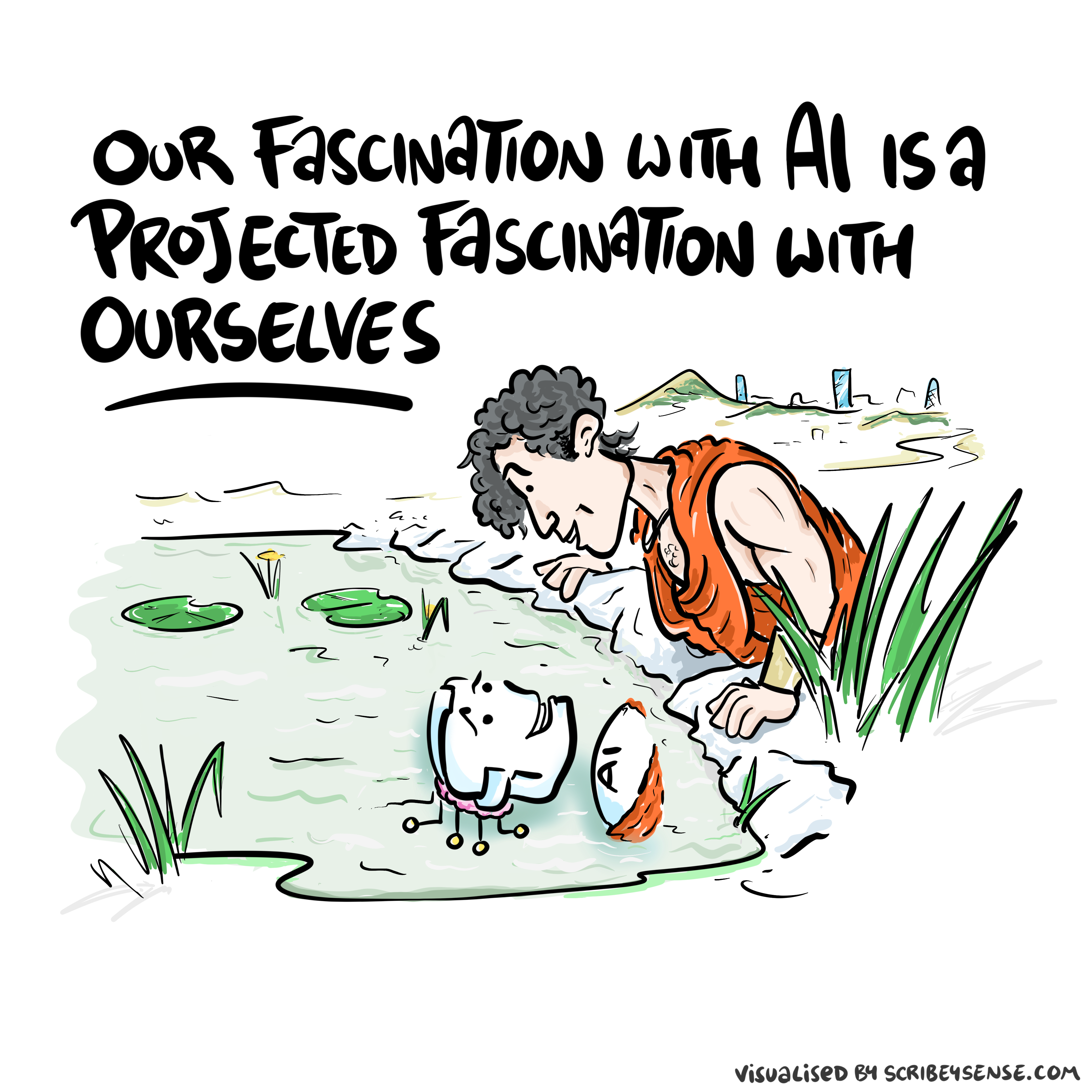

Figure: This is the drawing Dan was inspired to create for Chapter 1. It captures the fundamentally narcissistic nature of our (societal) obsession with our intelligence.
See blog post on Dan Andrews image of our reflective obsession with AI.. See also (Vallor, 2024).
Where does the Atomic Human lie?
The answer I give in the book, is that the atomic human is found in our weakness and vulnerabilities and how we overcome them. Anything that we view as a measurable capability is likely to be replaced by the machine. But our weaknesses (such as our locked-in intelligence) are intrinsic to who we are.
Computer Conversations

Figure: Conversation relies on internal models of other individuals.

Figure: Misunderstanding of context and who we are talking to leads to arguments.
Similarly, we find it difficult to comprehend how computers are making decisions. Because they do so with more data than we can possibly imagine.
In many respects, this is not a problem, it’s a good thing. Computers and us are good at different things. But when we interact with a computer, when it acts in a different way to us, we need to remember why.
Just as the first step to getting along with other humans is understanding other humans, so it needs to be with getting along with our computers.
Embodiment factors explain why, at the same time, computers are so impressive in simulating our weather, but so poor at predicting our moods. Our complexity is greater than that of our weather, and each of us is tuned to read and respond to one another.
Their intelligence is different. It is based on very large quantities of data that we cannot absorb. Our computers don’t have a complex internal model of who we are. They don’t understand the human condition. They are not tuned to respond to us as we are to each other.
Embodiment factors encapsulate a profound thing about the nature of humans. Our locked in intelligence means that we are striving to communicate, so we put a lot of thought into what we’re communicating with. And if we’re communicating with something complex, we naturally anthropomorphize them.
We give our dogs, our cats, and our cars human motivations. We do the same with our computers. We anthropomorphize them. We assume that they have the same objectives as us and the same constraints. They don’t.
This means, that when we worry about artificial intelligence, we worry about the wrong things. We fear computers that behave like more powerful versions of ourselves that will struggle to outcompete us.
In reality, the challenge is that our computers cannot be human enough. They cannot understand us with the depth we understand one another. They drop below our cognitive radar and operate outside our mental models.
The real danger is that computers don’t anthropomorphize. They’ll make decisions in isolation from us without our supervision because they can’t communicate truly and deeply with us.
New Flow of Information
Classically the field of statistics focused on mediating the relationship between the machine and the human. Our limited bandwidth of communication means we tend to over-interpret the limited information that we are given, in the extreme we assign motives and desires to inanimate objects (a process known as anthropomorphizing). Much of mathematical statistics was developed to help temper this tendency and understand when we are valid in drawing conclusions from data.

Figure: The trinity of human, data, and computer, and highlights the modern phenomenon. The communication channel between computer and data now has an extremely high bandwidth. The channel between human and computer and the channel between data and human is narrow. New direction of information flow, information is reaching us mediated by the computer. The focus on classical statistics reflected the importance of the direct communication between human and data. The modern challenges of data science emerge when that relationship is being mediated by the machine.
Data science brings new challenges. In particular, there is a very large bandwidth connection between the machine and data. This means that our relationship with data is now commonly being mediated by the machine. Whether this is in the acquisition of new data, which now happens by happenstance rather than with purpose, or the interpretation of that data where we are increasingly relying on machines to summarize what the data contains. This is leading to the emerging field of data science, which must not only deal with the same challenges that mathematical statistics faced in tempering our tendency to over interpret data but must also deal with the possibility that the machine has either inadvertently or maliciously misrepresented the underlying data.
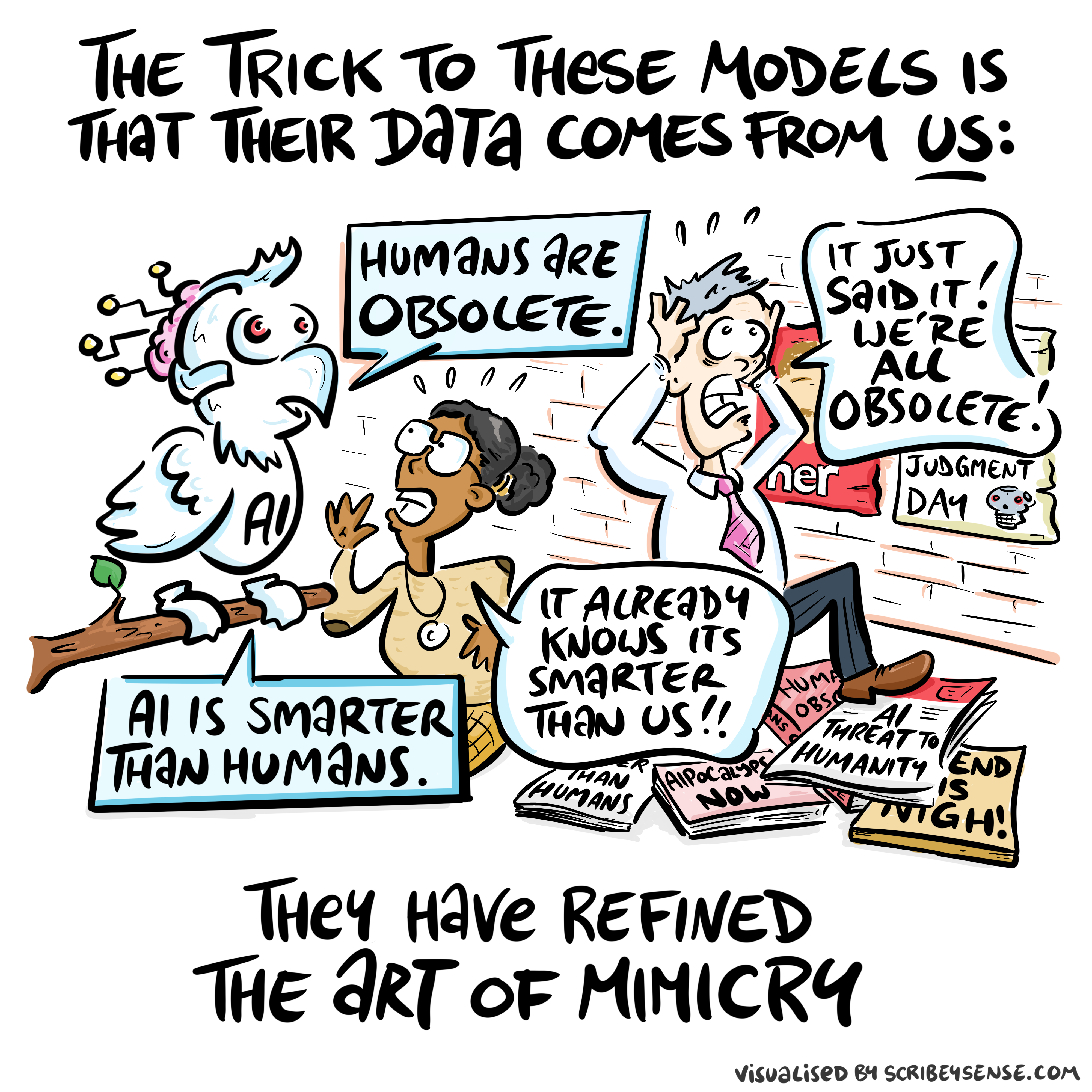

Figure: The nature of digital communication has changed dramatically, with machines processing vast amounts of human-generated data and feeding it back to us in ways that can distort our information landscape. (Illustration by Dan Andrews inspired by Chapter 5 “Enlightenment” of “The Atomic Human” Lawrence (2024))
This illustration was created by Dan Andrews after reading Chapter 5 “Enlightenment” of “The Atomic Human” book. The chapter examines how machine learning models like GPTs ingest vast amounts of human-created data and then reflect modified versions back to us. The drawing celebrates the stochastic parrots paper by Bender et al. (2021) while also capturing how this feedback loop of information can distort our digital discourse.
See blog post on Two Types of Stochastic Parrots.
See blog post on Two Types of Stochastic Parrots.
The stochastic parrots paper (Bender et al., 2021) was the moment that the research community, through a group of brave researchers, some of whom paid with their jobs, raised the first warnings about these technologies. Despite their bravery, at least in the UK, their voices and those of many other female researchers were erased from the public debate around AI.
Their voices were replaced by a different type of stochastic parrot, a group of “fleshy GPTs” that speak confidently and eloquently but have little experience of real life and make arguments that, for those with deeper knowledge are flawed in naive and obvious ways.
The story is a depressing reflection of a similar pattern that undermined the UK computer industry Hicks (2018).
We all have a tendency to fall into the trap of becoming fleshy GPTs, and the best way to prevent that happening is to gather diverse voices around ourselves and take their perspectives seriously even when we might instinctively disagree.
Sunday Times article “Our lives may be enhanced by AI, but Big Tech just sees dollar signs” Times article “Don’t expect AI to just fix everything, professor warns”
A Six Word Novel


Figure: Consider the six-word novel, apocryphally credited to Ernest Hemingway, “For sale: baby shoes, never worn”. To understand what that means to a human, you need a great deal of additional context. Context that is not directly accessible to a machine that has not got both the evolved and contextual understanding of our own condition to realize both the implication of the advert and what that implication means emotionally to the previous owner.
See Lawrence (2024) baby shoes p. 368.
But this is a very different kind of intelligence than ours. A computer cannot understand the depth of the Ernest Hemingway’s apocryphal six-word novel: “For Sale, Baby Shoes, Never worn”, because it isn’t equipped with that ability to model the complexity of humanity that underlies that statement.
Our shared vulnerabilities lead to a intricate mix of common purpose that is based on our common vulnerabilities.
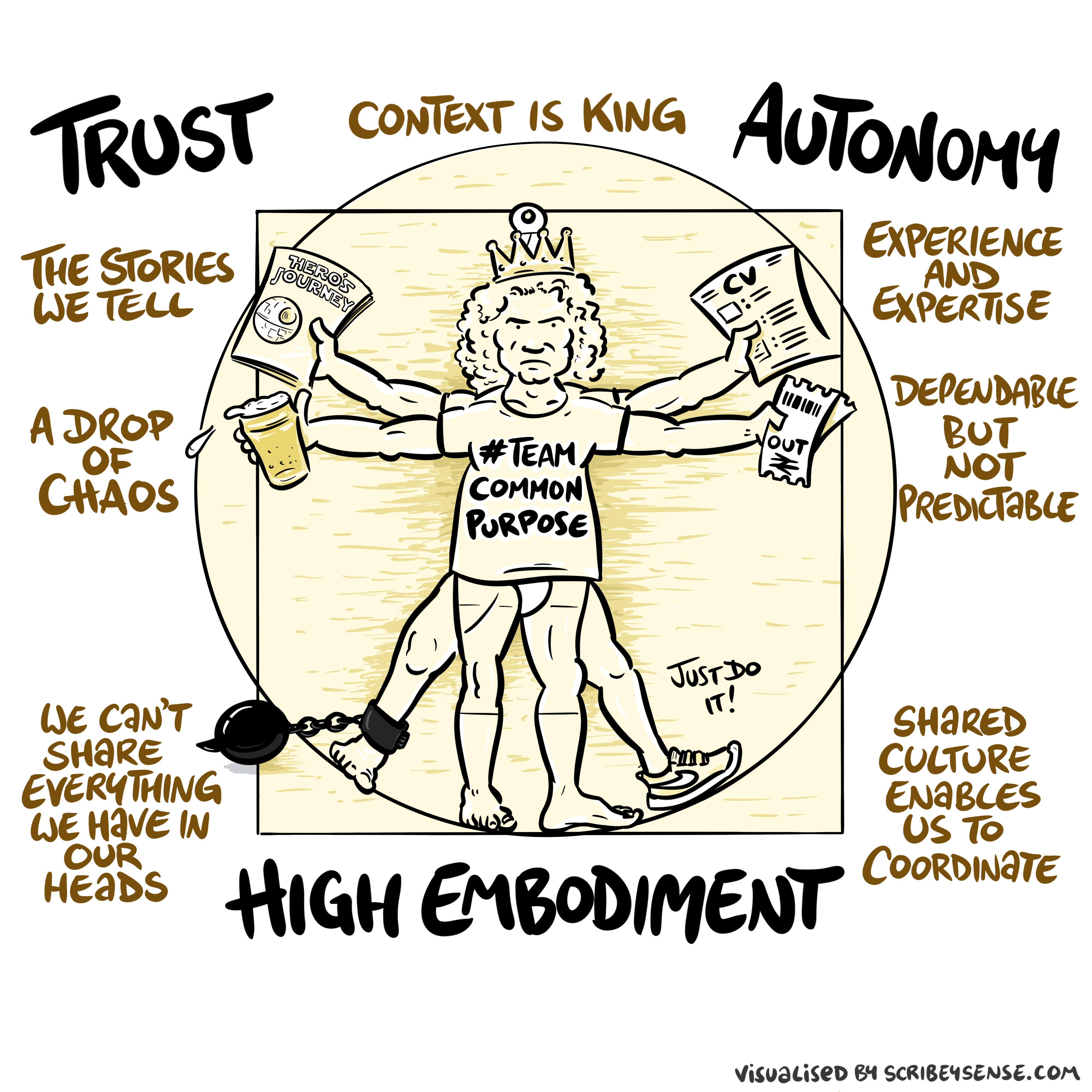

Figure: The relationships between trust, autonomy and embodiment are key to understanding how to properly deploy AI systems in a way that avoids digital autocracy. (Illustration by Dan Andrews inspired by Chapter 3 “Intent” of “The Atomic Human” Lawrence (2024))
This illustration was created by Dan Andrews after reading Chapter 3 “Intent” of “The Atomic Human” book. The chapter explores the concept of intent in AI systems and how trust, autonomy, and embodiment interact to shape our relationship with technology. Dan’s drawing captures these complex relationships and the balance needed for responsible AI deployment.
See blog post on Dan Andrews image from Chapter 3.
See blog post on Dan Andrews image from Chapter 3..
When it comes to the international conversation around AI, we find a distortion of who we are that emerges from an overly reductive vew of human nature. This view was captured by William Blake when assessing the influence of Newton’s philosophies on the emerging industrial world around him.
Blake’s Newton
William Blake’s rendering of Newton captures humans in a particular state. He is trance-like absorbed in simple geometric shapes. The feel of dreams is enhanced by the underwater location, and the nature of the focus is enhanced because he ignores the complexity of the sea life around him.


Figure: William Blake’s Newton. 1795c-1805
See Lawrence (2024) Blake, William Newton p. 121–123.
The caption in the Tate Britain reads:
Here, Blake satirises the 17th-century mathematician Isaac Newton. Portrayed as a muscular youth, Newton seems to be underwater, sitting on a rock covered with colourful coral and lichen. He crouches over a diagram, measuring it with a compass. Blake believed that Newton’s scientific approach to the world was too reductive. Here he implies Newton is so fixated on his calculations that he is blind to the world around him. This is one of only 12 large colour prints Blake made. He seems to have used an experimental hybrid of printing, drawing, and painting.
From the Tate Britain
See Lawrence (2024) Blake, William Newton p. 121–123, 258, 260, 283, 284, 301, 306.
Lunette Rehoboam Abijah
Many of Blake’s works are inspired by engravings he saw of the Sistine chapel ceiling. The pose of Newton is taken from the Lunette depiction of Abijah, one of the Michelangeo’s ancestors of Christ.


Figure: Lunette containing Rehoboam and Abijah.
People, Communication and Culture
Human intelligence is a social intelligence: it is isolated, but it doesn’t exist in isolation. It sits instead within a broader culture. The term ‘culture’ originates from the Roman orator Cicero, who wrote of cultura animi, the cultivation of our minds. He drew an analogy with agriculture: human knowledge is cultivated similarly to the way crops are raised from the land: our minds grow and respond to their intellectual environment.
It is impossible to understand humans without understanding our context, and human culture is a key part of that context, but the cul- ture that sustains our minds is also evolving. Over time, how we see ourselves within the universe has changed. The world looks different to us today than it did to Michelangelo. Many of these changes have improved our ability to understand the world around us.

Figure: People communicate through artifacts and culture.
See Lawrence (2024) Cicero and culture p. 20-21.


Figure: This is the drawing Dan was inspired to create for Chapter 4. It highlights how even if these machines can generate creative works the lack of origin in humans menas it is not the same as works of art that come to us through history.
See blog post on Art is Human..
For the Working Group for the Royal Society report on Machine Learning, back in 2016, the group worked with Ipsos MORI to engage in public dialogue around the technology. Ever since I’ve been struck about how much more sensible the conversations that emerge from public dialogue are than the breathless drivel that seems to emerge from supposedly more informed individuals.
There were a number of messages that emerged from those dialogues, and many of those messages were reinforced in two further public dialogues we organised in September.
However, there was one area we asked about in 2017, but we didn’t ask about in 2024. That was an area where the public unequivocal that they didn’t want the research community to pursue progress. Quoting from the report (my emphasis).
Art: Participants failed to see the purpose of machine learning-written poetry. For all the other case studies, participants recognised that a machine might be able to do a better job than a human. However, they did not think this would be the case when creating art, as doing so was considered to be a fundamentally human activity that machines could only mimic at best.
Public Views of Machine Learning, April, 2017
How right they were.
So if it is not possible to recreate our intelligence, if the atomic human is preserved, what is it that we have created? To understnd this we’ll first introduce the notion of an analogue computer.
The MONIAC
The MONIAC was an analogue computer designed to simulate the UK economy. Analogue comptuers work through analogy, the analogy in the MONIAC is that both money and water flow. The MONIAC exploits this through a system of tanks, pipes, valves and floats that represent the flow of money through the UK economy. Water flowed from the treasury tank at the top of the model to other tanks representing government spending, such as health and education. The machine was initially designed for teaching support but was also found to be a useful economic simulator. Several were built and today you can see the original at Leeds Business School, there is also one in the London Science Museum and one in the Unisversity of Cambridge’s economics faculty.
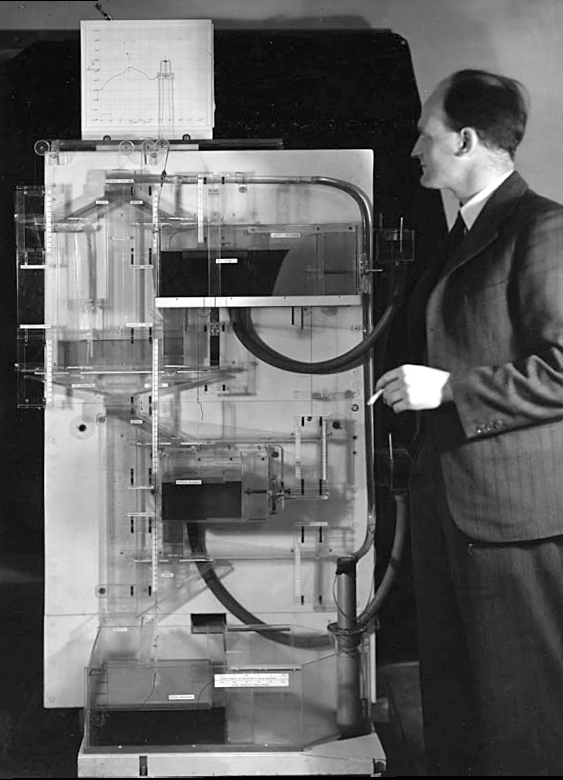

Figure: Bill Phillips and his MONIAC (completed in 1949). The machine is an analogue computer designed to simulate the workings of the UK economy.
See Lawrence (2024) MONIAC p. 232-233, 266, 343.
Human Analogue Machine
Recent breakthroughs in generative models, particularly large language models, have enabled machines that, for the first time, can converse plausibly with other humans.
The Apollo guidance computer provided Armstrong with an analogy when he landed it on the Moon. He controlled it through a stick which provided him with an analogy. The analogy is based in the experience that Amelia Earhart had when she flew her plane. Armstrong’s control exploited his experience as a test pilot flying planes that had control columns which were directly connected to their control surfaces.

Figure: The human analogue machine is the new interface that large language models have enabled the human to present. It has the capabilities of the computer in terms of communication, but it appears to present a “human face” to the user in terms of its ability to communicate on our terms. (Image quite obviously not drawn by generative AI!)
The generative systems we have produced do not provide us with the “AI” of science fiction. Because their intelligence is based on emulating human knowledge. Through being forced to reproduce our literature and our art they have developed aspects which are analogous to the cultural proxy truths we use to describe our world.
These machines are to humans what the MONIAC was the British economy. Not a replacement, but an analogue computer that captures some aspects of humanity while providing advantages of high bandwidth of the machine.
HAM
The Human-Analogue Machine or HAM therefore provides a route through which we could better understand our world through improving the way we interact with machines.

Figure: The trinity of human, data, and computer, and highlights the modern phenomenon. The communication channel between computer and data now has an extremely high bandwidth. The channel between human and computer and the channel between data and human is narrow. New direction of information flow, information is reaching us mediated by the computer. The focus on classical statistics reflected the importance of the direct communication between human and data. The modern challenges of data science emerge when that relationship is being mediated by the machine.
The HAM can provide an interface between the digital computer and the human allowing humans to work closely with computers regardless of their understandin gf the more technical parts of software engineering.

Figure: The HAM now sits between us and the traditional digital computer.
Of course this route provides new routes for manipulation, new ways in which the machine can undermine our autonomy or exploit our cognitive foibles. The major challenge we face is steering between these worlds where we gain the advantage of the computer’s bandwidth without undermining our culture and individual autonomy.
See Lawrence (2024) human-analogue machine (HAMs) p. 343-347, 359-359, 365-368.
Bandwidth vs Complexity
The computer communicates in Gigabits per second, One way of imagining just how much slower we are than the machine is to look for something that communicates in nanobits per second.

|
|||
| bits/min | \(100 \times 10^{-9}\) | \(2,000\) | \(600 \times 10^9\) |

Figure: When we look at communication rates based on the information passing from one human to another across generations through their genetics, we see that computers watching us communicate is roughly equivalent to us watching organisms evolve. Estimates of germline mutation rates taken from Scally (2016).

Figure: Bandwidth vs Complexity.
The challenge we face is that while speed is on the side of the machine, complexity is on the side of our ecology. Many of the risks we face are associated with the way our speed undermines our ecology and the machines speed undermines our human culture.
See Lawrence (2024) Human evolution rates p. 98-99. See Lawrence (2024) Psychological representation of Ecologies p. 323-327.
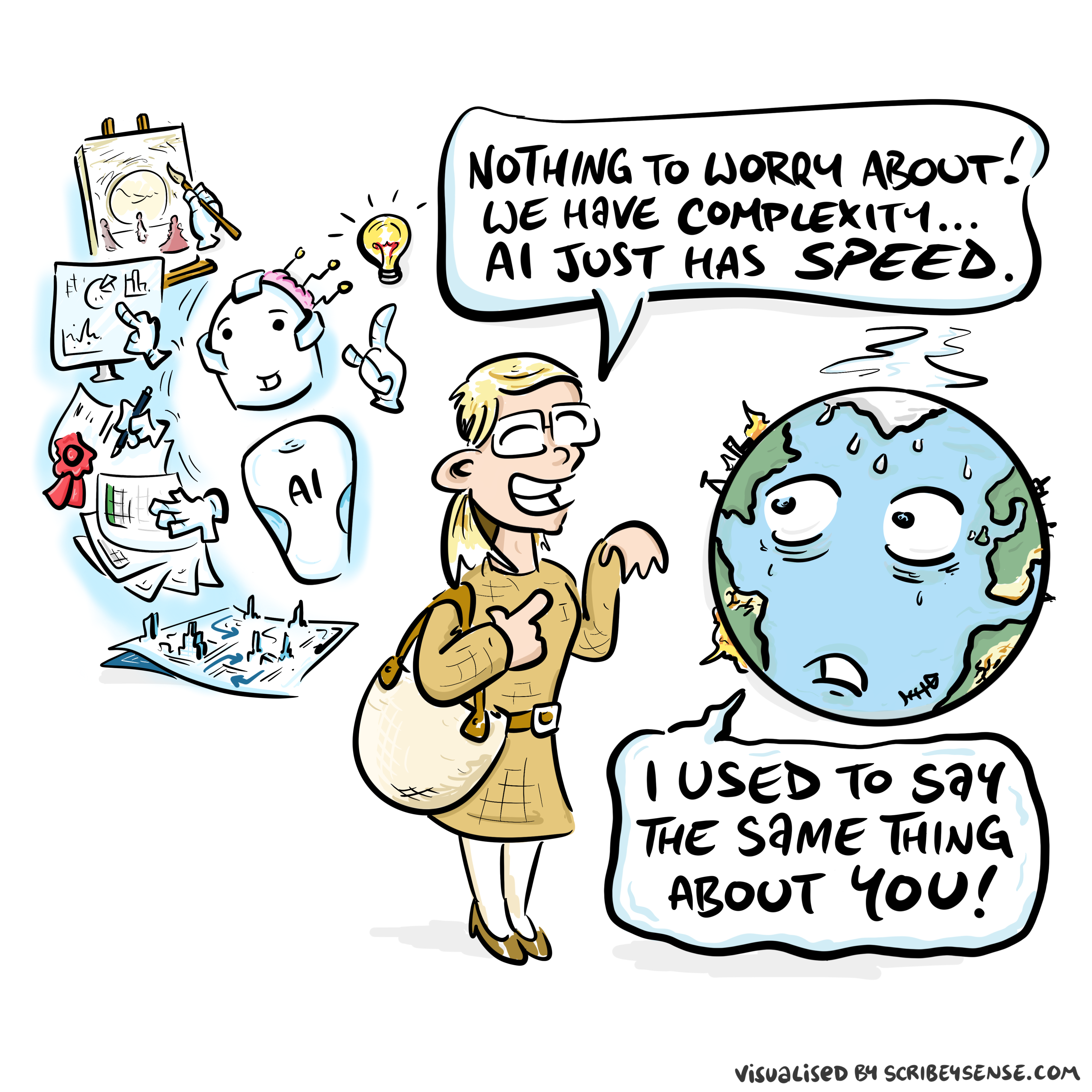

Figure: This is the drawing Dan was inspired to create for Chapter 12. It captures the challenge the analogy where the speed of information assimilation associated with machines is related to the speed assimilation associated with humans.
See blog post on the launch of Facebook’s AI lab..
We are in a moment where Africa has the opportunity not just to catch up with the rest of the world, but to lead it. This opportunity comes from understanding what I call the “atomic human” - our fundamental limitations and strengths as information processing beings.
Our bandwidth limitation is an intrinsic aspect of our intelligence that is overcome through our complex culture. When this culture is integrated in our thinking we can proceed with a more person centred approach to technology. We are in a wold where the bandwith gap has led governments to lose contact with their citizens, and companies to lose contact with their customers. The generative AI revolution offers an opportunity to put that right.
Bandwidth and Cultural Intelligence
To deal with our bandwidth limitation, human cultures have developed a landscap around us which allows us to refer to ideas and collaborate.
The challenge of human-computer interaction hasn’t been computational power, it’s the limited understanding machines have had of human culture. The HAM puts that right.
Challenge for Africa
The 5 Ps framework allows these cultural ideas to emerge from the community and enhance the strength of the institution. By placing people, projects and purpose first and allowing principles and process to follow the processes enhance the strengths of the institutions that are formed.
The Human Analogue Machine
The Human Analogue Machine represents a new interface paradigm that could position Africa advantageously in the next phase of digital transformation.
Africa’s HAM Advantage
The HAM represents a new paradigm for interaction between human and machine. It allows any human to directly leverage the machine’s massive bandwidth capability.
This has profound implications for all organisations. Corporate structures have evolved for processing and managing information, but when a radical new tool exists that allows us to change the way we manage information, existing corporate structures immediately become redundant.
Economists call this “path dependence” - past investments constrain their future choices. They have entire organisations, training programs, and infrastructure built around organising the human machine interactions around outdated models, for example the Bezos API mandate.
This means that being a late move organisationally can be an advantage. Countries and organizations that haven’t locked themselves into legacy approaches have more freedom to adopt better paradigms.
DSA exploits the fact that Africa has leapfrogged in other technologies, moving directly to mobile phones without extensive landline infrastructure. The HAM paradigm presents a similar opportunity.
Rather than trying to catch up to outdated models, you have the opportunity to pioneer approaches that the rest of the world will eventually need to adopt.
Understanding the difference between imposed and organically grown institutions is key for building sustainable systems that truly serve their communities.
Imposed vs Organic Institutions
African countries show incredibly high innovation potential, but can struggles with quality execution and sustained impact. Arguably this is an institutional problem. The structures of society operating on the continent were typically designed elsewhere and imposed. They embody assumptions about aspirations andcultural incentives that may not align with local cultural strengths and social structures.
When institutions don’t fit the cultural context, energy gets diverted into making them work. People spend time learning to operate within frameworks that don’t align with their natural ways of organising and collaborating.
We hear too many times the question “How can we make African communities work like Western institutions?”, rather than the question what does an institution look like that builds on the strengths of communities on the continent and ameliorates the cultural weaknesses. One that empowers the innovative instincts of entrepeneurs but supports them in delivering the necessary quality that makes a their work scalable and sustainable.
With AI this is particularly important. The international media is driving a narrative around an AI “race”. But what is the goal of this race? Without understanding that it can only be a race to the bottom. African countries have the opportunity to chose the game they place and set their own rules according to their citizens needs in a way that builds on thair cultural strengths.
The Five Ps Framework
The five Ps are: purpose, people, projects, principles, and process. The model is a useful framework for institution building that helps ensure initiatives become institutions that people will rely on.
The first P is purpose, because that’s the shared idea around which everything revolves. While people are critical, how do you bring the right people together? People convene around purpose.
But a purpose is often only loosely defined, so it’s important to move quickly from the purpose to define projects with actionable outcomes that individual people can agree on. A lofty purpose can be realised in many different ways, but actionable projects force the group to talk about the nitty-gritty about what everyone is trying to achieve and how they’re going about it.
As projects are developed, we can start to think about principles. These capture what it is about the projects that are working and help in choosing future directions. The principles are specific to the initiative, they characterise how the initiative goes about its work.
The final P is process. Process is necessary for sustainability in an institution. In any long-lived institution it may be easier to understand the process than the purpose. That’s because over time institutions evolve to have personalities that are suited to the role they find in society. Such institutions embed their learnings in their processes.
But, for a young agile institution it’s important to keep the balance between process and purpose right. Young projects that have placed process ahead of purpose should be avoided, but once the role of an initiative has been understood, developing process is an important part of consolidating the initiative.


Figure: In 2011 I caught up with John Quinn and met Ernest at a Dagstuhl seminar.
DSA: The 5 Ps Model in Action
The Origins of Data Science Africa
While Data Science Africa officially launched in 2015, its roots stretch back much further, emerging through a network of dedicated individuals and their collaborations.
The DSA story began for me when I met John Quinn at NeurIPS in 2005, where he published work on monitoring infants in neonatal intensive care. Once he had graduated he moved to Makerere University in Kampala. Fast forward another five years and we were together at a Dagstuhl Seminar, where I also met Ernest Mwebaze who was John’s PhD student at the time.
I was really struck by Ernest’s work. He presented on an algorithm for Crop Surveillance that was implemented on a $100 Android mobile phone. What struck me about Ernest’s work was the scope of its ambition. The talk was about a learned vector quantisation algorithm, but the algorithm wasn’t the point. The ambition was to place the algorithm in a farmer’s hands in a field in Uganda. Ernest was collaborating with Uganda’s national crop surveyors. The plan was to go end-to-end from the farmer’s field to the ministry of agriculture. It was the first time in machine learning that I’d seen someone attempting to bring all those components together.
I was impressed with Ernest and John’s work and wanted to find out more. John and Ernest were kind enough to invite me to Kampala for a research visit, I also suggested that I deliver some teaching while I was there. Two years later I visited John and Ernest with my PhD student Ricardo to deliver a short Gaussian process school. This was our first project together.
One thing I really enjoyed about the work there is on the fundamentals. I don’t mean fundamentals in terms of the mathematical properties of algorithms, but fundamentals in terms of what things work and what don’t. Working directly with farmers and the ministry of agriculture forces the focus to be on where the real challenges of successful deployment lie. They are rarely in the mathematics and compute but more often in the people and social environment where you are deploying.
There were lots of international projects in Kampala, and some (or many!) of them seemed to be quite clumsily implemented and harmful to local ecosystems.
I don’t think I left Kampala with a purpose in mind, but I had some early ideas for ways of working with my Kampalan collaborators. We also left with a further project. My student Ricardo and John’s PhD student Martin Mubangizi would work together on malaria prediction. And the plan was to go from the Ugandan health centres to the Ugandan ministry of health. We had people and we now we had projects.
This early work demonstrates how meaningful initiatives often begin - not with grand strategic plans, but with people who share interests connecting around practical problems. The purpose emerges through the work itself, rather than being imposed from above.
Data Science Africa
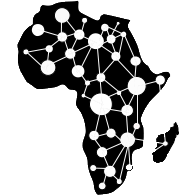

Figure: Data Science Africa https://datascienceafrica.org is a ground up initiative for capacity building around data science, machine learning and artificial intelligence on the African continent.

Figure: Data Science Africa meetings held up to October 2021.
Data Science Africa is a bottom up initiative for capacity building in data science, machine learning and artificial intelligence on the African continent.
As of May 2023 there have been eleven workshops and schools, located in seven different countries: Nyeri, Kenya (twice); Kampala, Uganda; Arusha, Tanzania; Abuja, Nigeria; Addis Ababa, Ethiopia; Accra, Ghana; Kampala, Uganda and Kimberley, South Africa (virtual), and in Kigali, Rwanda.
The main notion is end-to-end data science. For example, going from data collection in the farmer’s field to decision making in the Ministry of Agriculture. Or going from malaria disease counts in health centers to medicine distribution.
The philosophy is laid out in (Lawrence, 2015). The key idea is that the modern information infrastructure presents new solutions to old problems. Modes of development change because less capital investment is required to take advantage of this infrastructure. The philosophy is that local capacity building is the right way to leverage these challenges in addressing data science problems in the African context.
Data Science Africa is now a non-govermental organization registered in Kenya. The organising board of the meeting is entirely made up of scientists and academics based on the African continent.
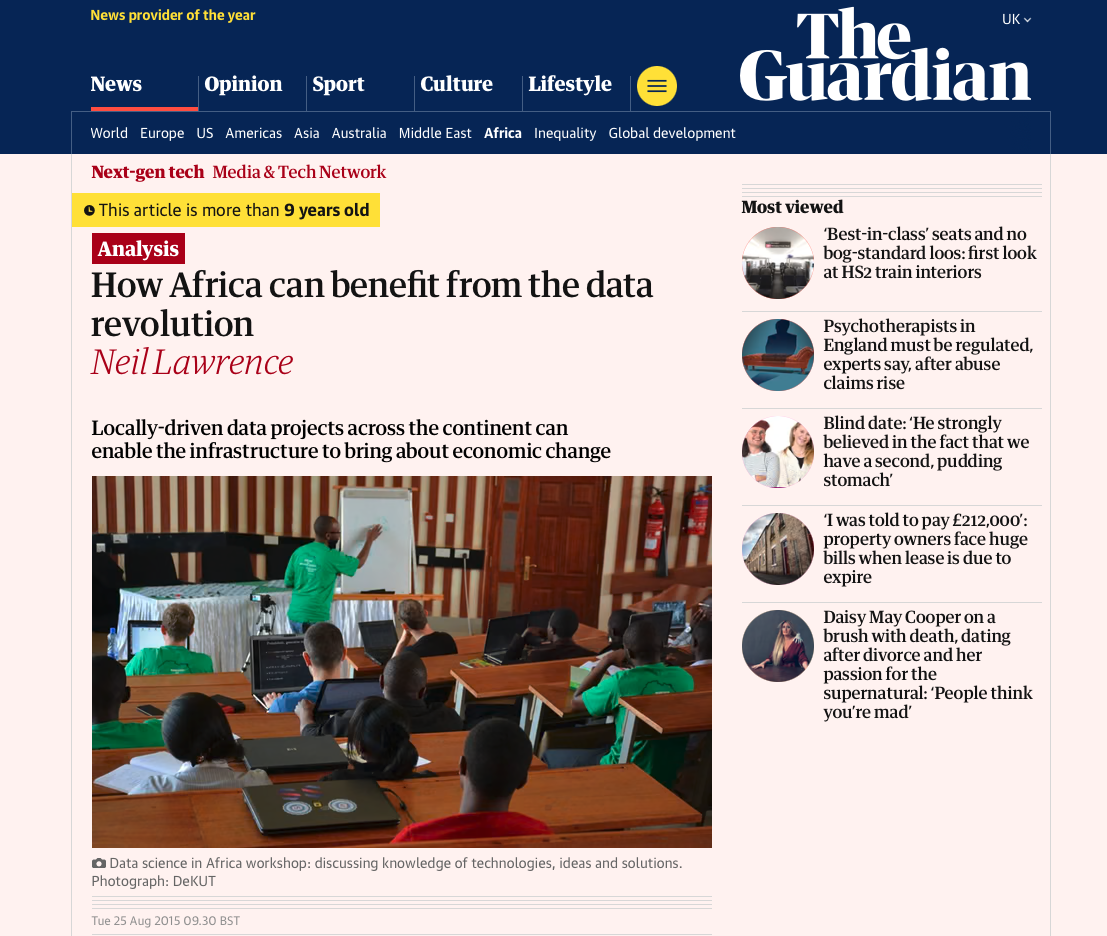

Figure: The lack of existing physical infrastructure on the African continent makes it a particularly interesting environment for deploying solutions based on the information infrastructure. The idea is explored more in this Guardian op-ed on Guardian article on How African can benefit from the data revolution.
Guardian article on Data Science Africa
Data Science Africa demonstrates the 5 Ps framework working in practice. It began with people - John Quinn and Ernest Mwebaze connecting through academic networks, not through formal organizational structures.
Projects emerged organically: the $100 Android phone for crop surveillance, connecting farmers to Uganda’s ministry of agriculture, malaria prediction linking health centres to the ministry of health. These weren’t planned as part of a grand strategy - they grew from local needs and practical opportunities.
Purpose crystallized through this work rather than being imposed from outside. The shared vision of African-led data science capacity building emerged from successful collaboration, not from donor mandates or institutional requirements.
DSA’s principles developed from experience. The focus on “fundamentals that work” - understanding deployment challenges in people and social environments rather than just mathematics and compute. Emphasis on building with local strengths rather than importing foreign models.
A governance system that prioritises wisdom over hierarchy and bureaucracy.
The 5 Ps framework comes from trying to characterise DSA’s success over the past decade. Not just for individual intiatives, but for the network itself. This model is now the foundation of how eare are trying to prepare Cambridge and the UK for AI with ai@cam. This shows that rather than trying to replicate Western institutional models, we can build on this demonstrated approach.
The framework allows people to share and leverage their existing strengths - while building institutions capable of competing globally. We have already build a model that others are learning from.
How this progresses is up to you. The strength of the 5 Ps is the purpose can emerge from the people through projects and the process operates in support of that vision.
DSA: The Next Ten Years
As Data Science Africa marks its 10th anniversary, we can envision how the next decade could position the continent as a global leader in human-centered AI and data science.
Data Science Africa has spent its first decade building foundations - establishing networks, developing local capacity, and demonstrating that African approaches to data science can be both rigorous and culturally grounded. The next decade presents an opportunity to move from building capacity to providing global leadership.
The question isn’t whether Africa can catch up to existing models of data science - it’s whether Africa can pioneer approaches that the rest of the world can learn from.
The next ten years will see a paradigm shift in corporate best practices. African entrepeneurs have a chance to place them selves at the heart of that debate. Building on rich cultural heritage, and the individual innovation we see all around us on the continet. But the glue that holds this together is institutions. We need to improve the quality of software that African engineers are writing, share the fruits of their labour with each other. We need a model for open innovation in the AI era that places African cultural practices and African needs at its heart. African traditions show that there is an inate understanding of these practices, but to build the quality solutions that form the foundation of the future African innovation ecosystem that inate cultural knowledge needs to be translated into the institutions that will be the foundation of the 21st century.
This means moving beyond developing people to developing new institutions. Institutiosn that translate African capabilities into deployed innovations. No longer is it enoguh to just African capacity in data science, but to establish African approaches as essential components of global data science practice.
DSA’s first decade was has been founded on a set of principles that responded to African communities with African needs. But to translate these ideas into the innovations that are supporting African citizens to fulfil their aspirations we need every member of DSA to be striving to build their own visions of the future that are informed by the success that European institutional models have achieved but are not tethered by it.
DSA collaborations between between local data scientists and international partners are already characterised by mutual learning rather than one-way knowledge transfer. Why shouldn’t this also be the case for new generation of AI-first companies?
The atomic human isn’t only about understanding our limitations - it’s about building systems that overcome them by working in synergy with who we are.
The new paradigm of the HAM leaves an opportunity for Africa to show the world what this looks like in practice. Not by copying what others have done, but by building on the continent’s own strengths and approaches. The 5 Ps framework was developed here by this community, it can now be deployed here to support the wider community.
By building these communities decade after decade, eventually we’ll be in a position where the question is no longer whether Africa can catch up to the rest of the world. Instead it becomes whether the rest of the world can keep up with Africa’s innovation in human-grounded technology and instituions.
Thanks!
For more information on these subjects and more you might want to check the following resources.
- book: The Atomic Human
- twitter: @lawrennd
- podcast: The Talking Machines
- newspaper: Guardian Profile Page
- blog: http://inverseprobability.com